5.3.1
advertisement
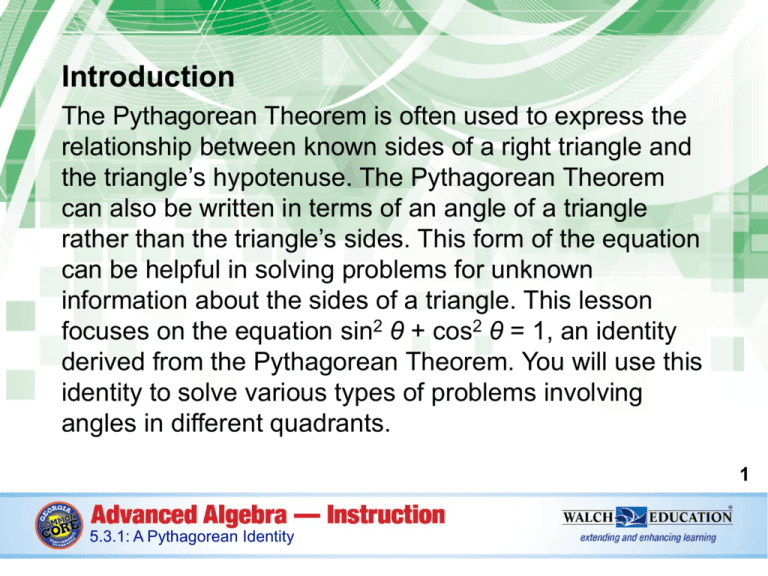
Introduction The Pythagorean Theorem is often used to express the relationship between known sides of a right triangle and the triangle’s hypotenuse. The Pythagorean Theorem can also be written in terms of an angle of a triangle rather than the triangle’s sides. This form of the equation can be helpful in solving problems for unknown information about the sides of a triangle. This lesson focuses on the equation sin2 θ + cos2 θ = 1, an identity derived from the Pythagorean Theorem. You will use this identity to solve various types of problems involving angles in different quadrants. 1 5.3.1: A Pythagorean Identity Key Concepts • An identity is an equation that is true regardless of what values are chosen for the variables. • A Pythagorean identity is a trigonometric equation that is derived from the Pythagorean Theorem. The primary Pythagorean identity is sin2 θ + cos2 θ = 1. Other Pythagorean identity equations involving different trigonometric functions (i.e., tangents, secants) also exist. Pythagorean identities express the relationships among the sides and angles of a right triangle inscribed in a unit circle, as shown on the following slide. 2 5.3.1: A Pythagorean Identity Key Concepts, continued 3 5.3.1: A Pythagorean Identity Key Concepts, continued • Recall that the Pythagorean Theorem, a2 + b2 = c2, states that the length of the longest side of a right triangle—the hypotenuse, c—is equal to the sum of the squares of the lengths of the other two sides, a and b. • Also, remember that the center of the unit circle is located at the origin of the coordinate plane. The unit circle has a radius of 1, which is also the length of the hypotenuse of a right triangle drawn in the unit circle. Since c2 = 1, the Pythagorean Theorem, when applied to a unit circle, can be written as a2 + b2 = 1. • Recall that quadrants divide the coordinate plane by an xand y-axis; counterclockwise starting at the top right quadrant, the four quadrants are labeled I, II, III, and IV. 5.3.1: A Pythagorean Identity 4 Key Concepts, continued • The following diagrams express the sine and cosine of an angle θ in a right triangle inscribed within each quadrant of the unit circle. Quadrant I Angle θ is between 0° and 90°; sin θ and cos θ are both positive. 5.3.1: A Pythagorean Identity Quadrant II Angle θ is between 90° and 180°; sin θ is positive and cos θ is negative. 5 Key Concepts, continued Quadrant III Angle θ is between 90° and 270°; sin θ and cos θ are both negative. Quadrant IV Angle θ is between 270° and 360°; sin θ is negative and cos θ is positive. 6 5.3.1: A Pythagorean Identity Key Concepts, continued • The following table shows the values of θ in degrees and radians for each triangle in the diagrams, as well as sin2 θ and cos2 θ. The final column of the table shows the sum of sin2 θ and cos2 θ for each angle measure. 7 5.3.1: A Pythagorean Identity Key Concepts, continued θ in radians Quadrant I II III IV p 2 sin2 θ cos2 θ sin2 θ + cos2 θ 90° 1 0 1 radians 200° 0.12 0.88 1 radians 270° 1 0 1 radians 320° 0.41 0.59 1 radians 10p 9 3p 2 16p 9 θ in degrees 8 5.3.1: A Pythagorean Identity Key Concepts, continued • Notice that all of the values for sin2 θ + cos2 θ are equal to 1. This indicates that sin2 θ + cos2 θ = 1 is an identity because the equation remains true for any value of θ. 9 5.3.1: A Pythagorean Identity Common Errors/Misconceptions • misinterpreting variables from a word problem • miscalculating expressions involving decimals • using radians instead of degrees and vice versa • incorrectly choosing the reference angle 10 5.3.1: A Pythagorean Identity Guided Practice Example 1 Use a graphing calculator to graph y = sin2 θ + cos2 θ and y = 1 on the same graph. What do you observe about these two graphs? 11 5.3.1: A Pythagorean Identity Guided Practice: Example 1, continued 1. Graph y = sin2 θ + cos2 θ. The graph should appear as follows. 12 5.3.1: A Pythagorean Identity Guided Practice: Example 1, continued 2. Graph y = 1. On the same coordinate plane, graph the equation y = 1. 13 5.3.1: A Pythagorean Identity Guided Practice: Example 1, continued 3. Make an observation about the graphs of y = sin2 θ + cos2 θ and y = 1. It can be seen from the graph that the two graphs are the same. Therefore, the equations are equal: y = 1 = sin2 θ + cos2 θ. ✔ 14 5.3.1: A Pythagorean Identity Guided Practice: Example 1, continued 15 5.3.1: A Pythagorean Identity Guided Practice Example 3 1 Given that sin A = , what is the value of cos A if angle A 2 lies in the first quadrant of the coordinate plane? Round your answer to the nearest hundredth. 16 5.3.1: A Pythagorean Identity Guided Practice: Example 3, continued 1. Use the Pythagorean identity sin2 θ + cos2 θ = 1 to determine the value of cos A. For this problem, replace θ with A in the identity equation: sin2 A + cos2 A = 1. 1 Substitute sin A = into the identity equation and 2 solve for cos A. sin2 A + cos2 A = 1 2 æ 1ö equation 2 + cos A=1 çè 2 ÷ø 5.3.1: A Pythagorean Identity Pythagorean identity 1 Substitute 2 for sin A. 17 Guided Practice: Example 3, continued 1 4 + cos2 A = 1 cos A = 2 cos A = ± 3 4 3 4 cos A » ±0.87 Simplify. Subtract 1 from both sides. 4 Take the square root of both sides. Simplify using a calculator. cos A is approximately equal to ±0.87. 18 5.3.1: A Pythagorean Identity Guided Practice: Example 3, continued 2. Determine the value of cos A if angle A lies in the first quadrant. In the first quadrant, cosine is positive, so use the positive square root for the result. Therefore, cos A is approximately equal to 0.87. ✔ 19 5.3.1: A Pythagorean Identity Guided Practice: Example 3, continued 20 5.3.1: A Pythagorean Identity


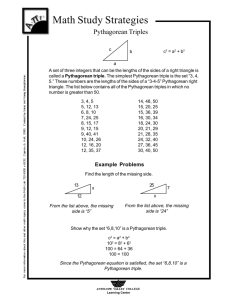
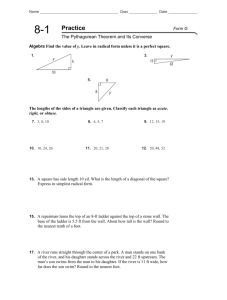

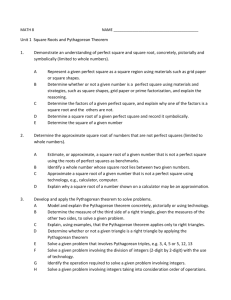
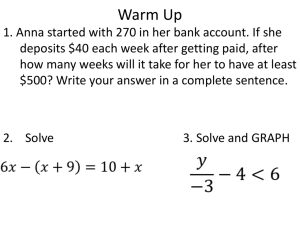
![Pythagorean Theorem Choice Menu]](http://s3.studylib.net/store/data/006637104_1-ef489d42c5b94dc2216093dd08d2b47e-300x300.png)